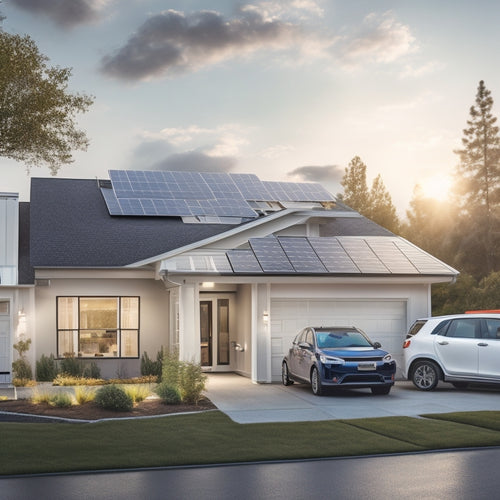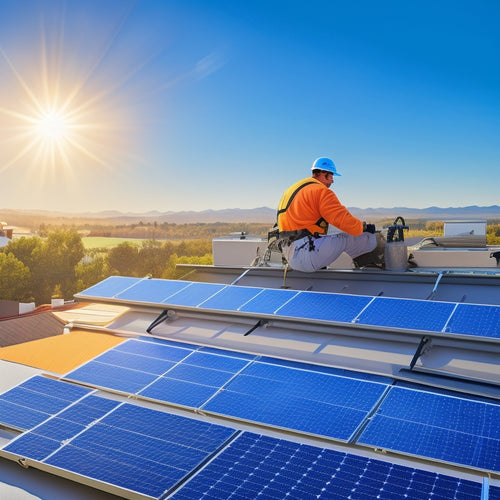
Achieving Energy Independence With Solar Power Essentials
Share
You're taking the first step towards energy independence by investing in solar power, a clean and renewable energy source that can greatly reduce your carbon footprint and reliance on the grid. As you start this expedition, it's crucial to understand the basics of solar power, assess your energy needs and costs, and choose the right solar panels, inverters, and mounting systems for your unique situation. From there, you'll need to evaluate energy storage and backup options, installation and maintenance strategies, financing and incentive opportunities, and how to connect with the grid and monitor your system's performance. Now, get ready to investigate the specifics that'll help you achieve energy independence.
Key Takeaways
- Assess energy needs by analyzing past utility bills and identifying peak consumption periods to size the solar panel system correctly.
- Select high-quality solar panels with a long warranty, high performance ratings, and a reputable brand for optimal energy output.
- Consider energy storage solutions like batteries and backup generators to ensure a reliable energy supply during low sunlight or grid outages.
- Proper installation and regular maintenance are crucial to optimize solar panel performance, including cleaning schedules and inverter monitoring.
- Explore financing options, such as federal rebates, state incentives, and loan programs, to reduce upfront costs and make solar energy more accessible.
Understanding Solar Power Basics
Your expedition into solar power begins with a fundamental understanding of how it works. Solar power utilizes energy from the sun, converting it into electrical energy through photovoltaic (PV) cells. These cells, made from semiconducting materials, release electrons when exposed to sunlight, generating an electric current. The current is then collected and inverted into usable alternating current (AC) electricity.
Recent solar technology advancements have greatly improved efficiency and reduced costs. Thin-film technology, for instance, allows for more flexible and efficient panels. Additionally, advancements in inverter technology have enabled smoother, more reliable energy output.
As you investigate solar power, it's crucial to take into account its environmental impact. Solar energy is a clean, renewable source, producing no emissions or pollution during operation. By adopting solar power, you'll reduce your carbon footprint and contribute to a more sustainable future.
With a solid grasp of these basics, you'll be well-equipped to make informed decisions about incorporating solar power into your energy strategy.
Assessing Energy Needs and Costs
Now that you have a solid understanding of solar power basics, it's time to evaluate how solar power can meet your specific energy needs. To do this, you'll need to assess your energy consumption patterns and costs.
Start by analyzing your past utility bills to identify your average daily energy usage and peak consumption periods. This will help you determine the size of the solar panel system you'll need to meet your energy demands.
Next, conduct a cost analysis to compare your current utility rates with the long-term savings of switching to solar power. Consider factors like the upfront cost of installation, maintenance expenses, and potential incentives or rebates. This will give you a clear illustration of the financial benefits of shifting to renewable sources.
An efficiency assessment is also essential to determine how much energy your solar panel system can produce. This will help you identify areas where you can optimize your energy usage and maximize your savings.
Choosing the Right Solar Panels
With a clear understanding of your energy needs and costs, you're ready to select the right solar panels for your system. The type of panel you choose will considerably impact your system's performance and overall cost.
You'll need to take into account factors like panel types, including monocrystalline, polycrystalline, and thin-film options. Warranty considerations are also vital, as a longer warranty can provide peace of mind and protection against defects or malfunctions.
When evaluating panel performance, look at installation placement, as well as performance ratings, which are typically measured regarding efficiency and power output. Brand reputation is also important, as a reputable brand can guarantee high-quality panels and reliable customer support.
Don't forget to reflect on the environmental impact of your panel choice, as some options are more eco-friendly than others. Finally, compare costs and assess aesthetic options, such as panel color and frame type, to guarantee your system blends in with your home's design.
Inverters and Mounting Systems
You've selected your solar panels, now it's time to focus on the inverters that convert the DC power they produce into usable AC power, and the mounting systems that securely fasten your panels to your roof or ground.
You'll need to decide between string inverters, microinverters, and power optimizers, each with their own strengths and weaknesses.
Inverter Types Compared
In the heart of every solar power system lies an essential component: the inverter. As you assess your solar power system options, you'll come across different types of inverters, each with its advantages and disadvantages.
When choosing an inverter, consider the following types:
-
String Inverter: Connects multiple solar panels in a single string, offering high inverter efficiency but limited panel-level monitoring.
-
Micro Inverter: Attached to each solar panel, providing individual panel monitoring and optimization, but at a higher cost.
-
Power Optimizer: Combines the benefits of string and micro inverters, offering panel-level monitoring and optimization at a lower cost.
- Hybrid Inverter: Integrates solar power with energy storage, enabling you to store excess energy for later use.
When selecting an inverter, consider factors such as inverter installation, lifespan, warranties, compatibility with your solar panels, and monitoring capabilities.
Mounting System Options
Beyond the inverter, a solar power system's reliability hinges on a sturdy mounting system that securely fastens your solar panels to your roof or ground.
You'll need to choose a mounting system that suits your specific installation requirements. Fixed mounts provide a cost-effective solution for installations with minimal obstructions. Adjustable racks, on the other hand, allow for seasonal adjustments to enhance energy production.
Pole mounts are ideal for ground-mounted systems, while roof attachments guarantee a secure fit on your rooftop. Ground systems offer flexibility and are often used for large-scale installations.
Tracking systems enable your panels to follow the sun's movement, maximizing energy output. Hybrid solutions combine different mounting options to achieve peak performance.
When selecting a mounting system, consider aesthetic options that blend seamlessly with your home's design. Additionally, verify the system is compatible with your inverter and meets local building codes.
Efficiency Optimization Tips
Most solar power systems can benefit from a 10-20% increase in energy production by fine-tuning inverter and mounting system performance.
By refining these components, you'll be able to maximize sunlight exposure and tracking performance, resulting in more energy generated.
To enhance your system's efficiency, consider the following:
-
Tilt and angle adjustments: Verify your panels are installed at the ideal angle to capture the most sunlight throughout the day.
-
Inverter monitoring: Regularly check your inverter's performance to identify any potential issues or areas for improvement.
-
Shading analysis: Identify and address any shading issues that may be affecting your system's performance.
- Seasonal cleaning: Clean your panels regularly to maintain peak energy production.
Energy Storage and Backup Options
How do you guarantee a steady flow of electricity when the sun doesn't shine? The answer lies in energy storage and backup options. With solar power, you can't always rely on the sun to generate electricity. That's where battery technology comes in. Advances in battery technology have made it possible to store excess energy generated during the day for use at night or during power outages. This guarantees power reliability and energy resilience.
In addition to battery storage, backup generators can provide an extra layer of security. These generators can kick in during extended periods of low sunlight or grid outages, guaranteeing you have a steady supply of electricity.
Effective energy management is critical in integrating these storage solutions with your solar power system. By doing so, you can optimize your energy usage and reduce your reliance on non-renewable resources.
With the right energy storage and backup options, you can enjoy a reliable and sustainable supply of electricity, even when the sun isn't shining.
Installation and Maintenance Tips
When planning your solar power system installation, it's vital to guarantee a safe and efficient setup. You want to ascertain that your system is installed correctly to maximize energy production and minimize potential risks.
To achieve this, follow installation best practices, such as:
-
Hiring a certified installer: Make certain the installer has the necessary training and experience to handle your solar power system installation.
-
Assessing your roof's condition: Verify your roof is structurally sound and can support the weight of the solar panels.
-
Optimizing panel placement: Position panels to maximize energy production, considering factors like shade, orientation, and tilt.
- Labeling and documenting: Clearly label and document all electrical connections and components for easy maintenance and future reference.
Regular maintenance is vital to guarantee your solar power system operates at its best.
Create a maintenance schedule to check and clean panels, inspect electrical connections, and monitor system performance.
Financing and Incentive Options
As you navigate through the process of switching to solar power, considering financing and incentive options becomes an essential step in making your renewable energy goals a reality.
You'll want to examine federal rebates, state incentives, and tax credits that can greatly reduce the upfront cost of your solar panel system.
Loan programs and green mortgages can provide attractive financing options, while lease agreements and community solar initiatives offer alternative paths to energy independence.
Crowdfunding options are also emerging as a feasible way to fund your solar project.
To determine the best approach for your situation, employ financing calculators that can help you estimate the costs and benefits of different scenarios.
Grid Connection and Net Metering
You'll need to decide on a grid connection option that suits your solar power system's requirements, as it determines how you'll interact with the electrical grid.
You can choose between grid-tied systems, which allow you to export excess energy to the grid, or off-grid systems, which operate independently.
Grid-tied systems, in particular, enable you to take advantage of net metering, which measures the excess energy you export and provides credits towards your utility bills.
Grid Connection Options
Two primary options exist for connecting your solar power system to the grid: grid connection and net metering. These options allow you to integrate your solar power into the existing grid infrastructure, enabling you to offset your energy consumption and even sell excess energy back to the utility company.
When it comes to grid connection, you'll need to take into account the following key aspects:
-
Grid integration strategies: This involves synchronizing your solar power system with the grid's frequency and voltage to guarantee seamless energy transfer.
-
Utility partnerships: You'll need to establish a partnership with your utility company to facilitate the connection and metering process.
-
Grid connection equipment: This includes the necessary hardware, such as inverters and transformers, to connect your solar power system to the grid.
- Grid monitoring and control: This involves installing monitoring systems to track your energy production and consumption, as well as control systems to ascertain safe and efficient grid operation.
Solar Power Export
With grid connection and net metering, your solar power system becomes an active contributor to the grid, allowing you to export excess energy back to the utility company and offset your energy consumption. This setup enables you to sell the surplus energy you produce to the grid, reducing your reliance on traditional energy sources and generating revenue through solar export benefits.
When you export power, your net meter measures the energy you produce and subtracts it from the energy you consume. If you generate more than you use, the excess is fed back into the grid, and you receive credit for it. This credit can be carried over to future bills, reducing your energy expenses.
International regulations, such as the Paris Agreement, encourage the adoption of renewable energy sources like solar power, making it an attractive option for those seeking energy independence. By exporting excess energy, you not only reduce your carbon footprint but also contribute to a more sustainable energy environment.
Monitoring and Optimizing Performance
How efficiently is your solar power system performing? You need to monitor and enhance its performance to guarantee you're getting the most out of your investment.
With the right monitoring technologies, you can track your system's performance metrics in real-time. This includes energy usage, performance benchmarking, and data analytics.
To take control of your solar power system's performance, consider the following:
- Remote monitoring: Track your system's performance from anywhere, at any time, using online portals or mobile apps.
- System alerts: Receive notifications when your system is underperforming or experiencing technical issues.
- Maintenance scheduling: Schedule routine maintenance to ensure your system runs at peak levels.
- Data analytics: Analyze your energy usage patterns to identify areas for improvement.
Frequently Asked Questions
Can I Install Solar Panels on a Metal or Clay Tile Roof?
You'll need to assess your metal or clay tile roof's compatibility before installing solar panels, considering factors like weight capacity, structural integrity, and material compatibility to guarantee a secure and efficient installation.
Do Solar Panels Work During Power Outages?
When the grid goes down, you'll still have power if you've invested in battery storage, but without it, your solar panels won't work during outages since they're tied to the grid connection, ensuring safety and synchronization.
Are Solar Panels Resistant to Hail and Extreme Weather?
You're wondering if solar panels can withstand the fury of Mother Nature? Rest assured, most panels are designed to resist hail damage up to 1 inch in diameter and extreme weather conditions, ensuring your investment stays protected and productive.
Can I Use Solar Power to Charge My Electric Vehicle?
You can utilize solar charging to power your electric vehicle, enjoying EV benefits like zero emissions and lower operating costs, by installing a solar panel system that meets your vehicle's charging requirements and local building codes.
Do Solar Panels Require Regular Cleaning for Optimal Performance?
You're like a skilled chef, fine-tuning your solar setup for peak performance. Regular cleaning is essential; you'll want to wipe down your solar panels every 6-12 months, depending on your location, to guarantee optimal energy absorption and minimize energy losses.
Conclusion
As you commence your solar power expedition, you're not just slashing your reliance on fossil fuels, you're illuminating a path to autonomy. By utilizing the sun's energy, you're taking control of your electricity costs, mitigating climate change, and strengthening energy security. With the right system and savvy planning, you'll be basking in the glow of energy independence, free from the shackles of grid dependence, and ready to reap the rewards of a brighter, more sustainable future.
Related Posts
-

What Electric Vehicle Owners Need for Home Energy
As an electric vehicle owner, you need to optimize your home energy system to guarantee efficient, sustainable, and c...
-

What Role Do Unicycles Play in Urban Transport?
As you navigate through congested city streets, unicycles emerge as a viable solution, slashing carbon emissions by u...
-

3 Essential Steps for Solar Electricity Installation
To guarantee a successful solar electricity installation, you'll need to follow three essential steps. First, assess ...


